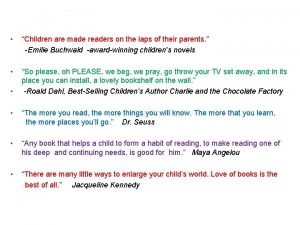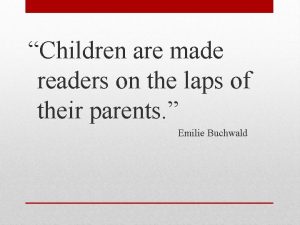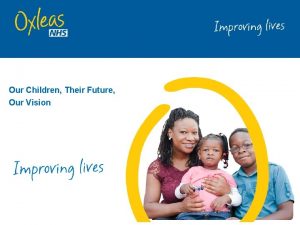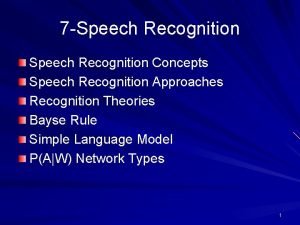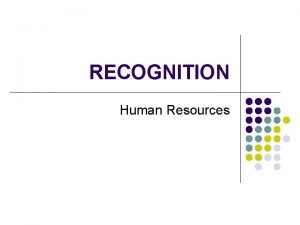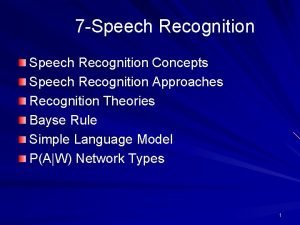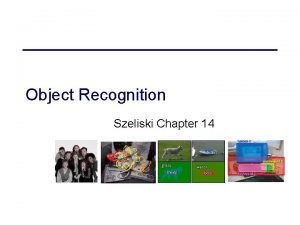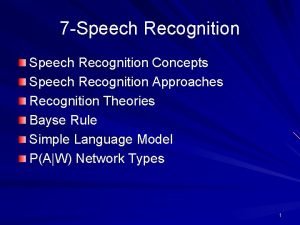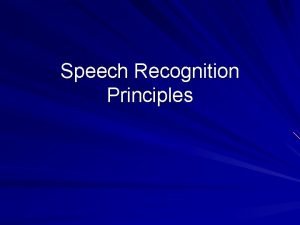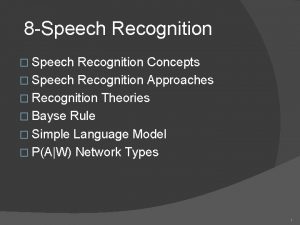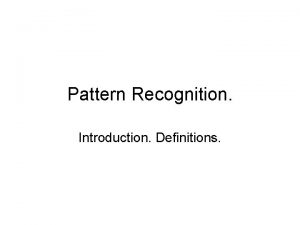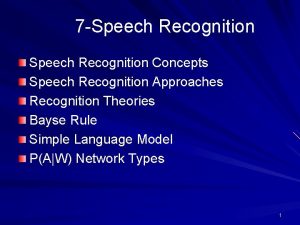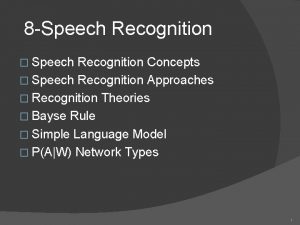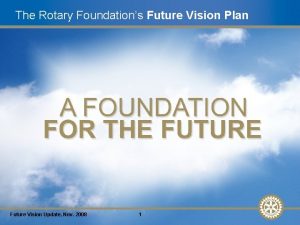Our Children Their Future Our Vision Recognition of

















- Slides: 17

Our Children, Their Future, Our Vision

'Recognition of Speech Language and Communication Needs (SLCN) and Classroom Strategies to Support' (In December 2011, the Expert Panel for the National Curriculum review called for spoken language to be included in the Curriculum for ALL subjects and throughout compulsory education)

Aims • To have an understanding about the range of Speech, Language and Communication Needs(SLCN) and occurrence within a mainstream school setting • To be able to identify SLCN in the classroom environment • To be familiar with strategies which can be used to support SLCN

Communication Pyramid Speech (e. g. speech intelligibility, fluency, voice) Expressive Language (e. g. immature grammar, limited vocabulary, disorganised or short sentences) Receptive Language (e. g. only remembering the last part of what is said, not understanding an instruction, giving an inappropriate answer to a question) Attention and Listening (e. g. finding it difficult to remain focused on a task, difficulty reengaging in a task once distracted, distracts peers) Social communication (e. g. difficulty making friends, saying the wrong things at the wrong time, poor pragmatic skills, limited emotional awareness)

Prevalence of Speech, Language and Communication Needs • In some parts of the country as many as 40– 50% of children have problems with speech, language and communication that could be addressed through a universal offer and through language rich environments(1). • There is a separate group of children, around 5– 7% of the total population, who have SLCN arising from having a specific language impairment (Developmental Language Disorder) (2 & 3) • Other children will have SLCN arising from other impairments, e. g. children with autism, many with cerebral palsy and many with learning disabilities. • In an ‘average’ mainstream classroom there will be 3 or 4 students with SLCN • “Needs can be appropriately met by a well-trained workforce in collaboration with specialist speech and language colleagues. ”- Communication Trust • • • References: 1 Basic Skills Agency (2002) Summary Report into Young Children’s Skills on Entry to Education 2 Lindsay, G. and Dockrell, J. with Mackie, C. and Letchford, R. (2002) Educational Provision for Children with Specific Speech and Language Difficulties in England Wales, CEDAR 3 Tomblin, J. B. , Records, N. L. Buckwalter, P. Zhang, X. , Smith, E. and O'Brien, M. (1997) The prevalence of specific language impairment in kindergarten children, Journal of Speech, Language and Hearing Research, 40, pp. 1245– 1260 5

Activity 1 – Insight into life with a SLCN • Please listen to the instructions and draw the picture • The objective is to give insight into having a communication impairment 6

Does you picture look like this? ! 7

THINKING POINT Think about a time when someone you were talking to did not seem to understand the point you were trying to make, or when they did not seem to hear you properly. • How did you feel? • Did you show your feelings? If so, how? 8

Case Study - Ryan O Year 9 Ryan’s difficulties • Ryan has mild to moderate receptive and expressive language difficulties • His main difficulties are word finding and slow processing Impact of these difficulties in the classroom • Ryan will struggle to understand use higher level vocabulary • Ryan will struggle to make semantic links between words • Ryan will take longer to process and understand information • Ryan will struggle to understand complex instructions How Ryan masks his difficulties • Ryan is very quiet and finds it difficult to ask for help if he is struggling • Ryan will try to get on with his work himself How you can support Ryan and similar students: • When teaching new key words give examples in context • Use opportunities in lessons to recap previous vocabulary learnt and make links between different words • Give extra time to process information e. g. ask him a question and tell him you will come back to him so that he has time to think and formulate his response • Repeat instructions to ensure understanding • Break down information into manageable chunks with visual support (pictures and symbols) 9

THINK ABOUT YOUR SPOKEN COMMUNICATION • Do they understand the words you are using? • Can they understand the questions you ask? • Do they need you to shorten and simplify your sentences? • Try to use literal language and avoid idioms • Try not to ask multiple questions as this can lead people to ‘clam up. ’ 10

If the person doesn’t understand then you could try: • Communicating more slowly and clearly and repeating what you have said. • Allowing the person more time to understand. Maybe give them time to think about what you have said and then come back to them for a response. • Simplifying what you have said using shorter and fewer words • Thinking more about your non-verbal communication. Avoid your body language saying something different from your words which will confuse the person • Support what you’re saying with signs or pictures • Use different ways to give the information e. g. drawing or showing what you mean by demonstration • Using literal language 11

ACTIVITY 2 – Thinking about YOUR language 1)Re-phrase these classroom instructions for a child with a language/social difficulty 2) What else would you do to try and support pupils to understand these instructions? 3) Anything else that you have tried that has/has not worked well with students with speech and language difficulties?

Think about these instructions …. - You won’t be permitted to visit the gallery unless your parent signs the consent slip. ” - Aaron, what do you think you’re doing? everyone’s working and you’re fiddling with that pen’ ‘Pull your socks up and get on with it - Describe the unscrupulous taxes that King Charles introduced and explain why this put him out of favour with his subjects. - Before you collect your coats, all but one person on each table need to put their tools away then give your homework to me and sit down. Refrain from talking while you do that please.

What to do if next • Try some of the Universal strategies suggested (further information has been provided in the handout) as these will help all students develop their communication skills, not just those students with difficulties • If good communication strategies have been used and concerns about specific students persist, speak to SLT for Targeted support • Following discussion with SENCO and/or SLT it may be felt that a student requires a referral to Speech and Language Therapy for Specialist assessment and advice • There has not been enough time to talk about specific SLCNs (e. g. speech, stammering, voice or social communication) today, but

Please do ask questions 15

Contact details • If you would like to find out about additional available training on SLCN or have specific questions about individual children or the Oxleas SLT service, please contact either: • Regarding students in SCALI (Julia Longthorne - julia. longthorne@nhs. net , Kate Harvey - kate. harvey 14@nhs. net) • Regarding students in mainstream (Laura Rigby – laura. rigby@nhs. net , Kate Harvey - kate. harvey 14@nhs. net) Or via • Oxleas Children’s services Single Point of Access, tel: 020 8836 8621 16

Thank you
 Future continuous tense rules
Future continuous tense rules Future perfect continuous and simple
Future perfect continuous and simple Our census our future
Our census our future Our census our future
Our census our future Our future is in our hands quotes
Our future is in our hands quotes Children are made readers on the laps of their parents
Children are made readers on the laps of their parents How does bagchi define his father's success
How does bagchi define his father's success Children are made readers on the laps of their parents
Children are made readers on the laps of their parents Cs766
Cs766 A vision for the future of genomics research
A vision for the future of genomics research Future vs future perfect
Future vs future perfect What is use in past tense
What is use in past tense Future continuous and future perfect
Future continuous and future perfect Future nurse programme
Future nurse programme Past continuous future tense
Past continuous future tense Plan present continuous
Plan present continuous Verbal times
Verbal times Future plans and finished future actions
Future plans and finished future actions





